|
[Front Page] [Features] [Departments] [Society Home] [Subscribe]

Electronic Mailbox
 
The following have been selected from the questions received on the SGAP World Wide web site over the past few months. You're welcome to comment on any issue concerning Australian native plants....growing, propagating or appreciating (even loathing!) ... anything.
If necessary, bung a message in a bottle if your net connection goes down!!
....and, if you'd like to contact any of the correspondents and no email address is listed, please feel free to do so through the editor.

Leaching Seed
I am in the process of preparing a manual for the Tree Seed Centre and came across information on leaching seed of Eriostemon and some Correa species from your web page. Please would you let me know whether this same information has been published in one of your magazines and if so the reference. Its would be better to refer to the actual reference than the web page.
Many thanks for your help.
Brian Gunn
CSIRO, Forestry and Forest Products
brian.gunn@ffp.csiro.au
The use of leaching for germination of Eriostemon australiaus was reported by McKintyre and Veitch of the (then) Canberra Botanic Gardens in the Society's journal "Australian Plants", Vol.6 p256-259, March 1972.
I don't know of any specific references for other Eriostemon (Philotheca) or Correa. However, the use of leaching for thse genera was reported by Elliott and Jones in The Encyclopaedia of Australian Plants Vol.1 p 207.
I hope this helps.

Correa for Cut Flowers??
Hi....The website has been great with all its info. Do you know if anyone is growing correas for the cut flower market - either domestic or export?
Prue Duffy
pdufty@iinet.net.au
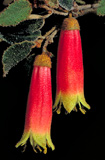
|
Not as far as I know. Correa is not a genus usually mentioned in the context of cut flowers. There would seem to be potential there though as the flowers seem resistant to wilting and hold their shape well. But perhaps they don't last well when cut.
Select the thumbnail image or highlighted name for a higher resolution image (27k).
|

Xanthorrhoea Nomenclature
While hitchhiking through OZ I was fasinated with what people called "Black
Boy Trees". Please could you tell me the correct mane of this tree and how I
could find out more information about it. Would this tree grow here in the
United States' climate and soil. Does it really need fire to propagate?
As a Tourist I have experienced more of your country than most citizens and I must say it's captured my heart.
Tmbo556321@aol.com
Glad to hear that you enjoyed your time downunder.
These are plants in the genus Xanthorrhoea, commonly called "grasstrees" - the name "black boy" is not favoured these days because it's demeaning to aboriginal people. Unfortunately many Australians still use that name.
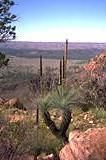
|
The plants range in size from very small , grass-like plants up to tall forms on black trunks which are probably the ones you saw. There are quite a number of different species.
They would probably grow in warmer parts of the USA - California, Arizona, New Mexico??? but I would not be confident of them surviving in the colder eastern states.
Select the thumbnail image or highlighted name for a higher resolution image (27k).
|
The big problem is that they are extremely slow growing. It may take 15-20 years for a tall species to form a substantial trunk. All of the large ones sold in Australian nurseries have been transplanted from wild populations.
They are generally adapted to areas which receive bushfires at regular intervals and tend to flower and set seed best in the year after a fire. However, they don't need fire to reproduce.
Hope this helps.

Grevillea Info
Could you please send me some info on "silky grevillea", G.sericea?
I have searched everywhere for this info. If you could help this would be greatly appreciated.
William
Australia
python@oznetcom.com.au
There is a fair bit of info about Grevillea sericea in many books on Australian native plants - good references that might be available in a library are "The Grevillea Book" Vol.3 by Peter Olde and Neil Marriott and "The Encyclopaedia of Australian Plants" Vol. 5 by Rodger Elliott and David Jones.
It is a small shrub to 1 - 1.5 metres. Simple leaves about 10-15 mm long. Flowers are in typical "spider" formation and are usually pale to deep pink but white forms are known. It occurs in eastern parts of NSW from about Heathcote to the Hunter and inland to around Mudgee.

|
The plant is reasonably hardy in cultivation. It prefers well drained sandy loam in full sun or part shade.
The photo shows the subspecies riparia, which is native to the lower Blue Mountains west of Sydney.
Select the thumbnail image or highlighted name for a higher resolution image (32k).
|

Problem with Tree Waratah
13 months ago we planted an Alloxylon which we bought in a 45 litre container and was about 1.5m high. It has grown very slowly and has a few problems.
- The new leaf tips turn brown and shrivel
- The older leaves have turned purple, and
- There are no signs of any flowers even though it had a few when we purchased it.
Our soil is quite sandy but is regularly watered and is mulched twice a year with newspaper, sugar cane and forest mulch.
When it was originally planted the hole was filled with Searle's Real Compost and since then Crop King fertiliser has been applied twice as well as blood and bone and Osmocote. At the same time we planted a Rhodosphaera which has almost tripled in size, a Tuckeroo and a Backhousia which are all thriving and all received the same treatment.
I have read my copy of Gardening Down Under to try and find out what it is lacking or otherwise and phosphorous is the only answer I can relate to the purpling but I can't work out if it has received to much or not enough. I also have a Brunfelsia planted in another garden which has the same purpling.
I would really appreciate a reply as I would hate to lose the Alloxylon.
Winnie Foster
Australia
wmcaf@powerup.com.au
It would certainly be a shame to lose it! Tree waratah is one of Australia's most magnificent flowering trees.
It's difficult to know precisely what's causing the problem but I think that excess fertilizer would be high on the list of probabilities.

|
You didn't mention where you are located so I can't comment on whether the climate is a problem. Judging by the other plants you mentioned, however, I doubt that this would be the cause of the trouble.
Select the thumbnail image or highlighted name for a higher resolution image (62k). Photo: Keith Townsend
|
Alloxylon can be slow to establish in comparison with other plants and can be a bit difficult to keep going for the first year or so even without fertiliser problems. I have a mature plant here in western Sydney (in sandy loam) but getting a second one to survive into its second year has been a problem.
Alloxylon is a member of the Protea family and these have special requirements in regard to fertiliser. They have a special root system ("proteoid roots") which are designed to take up nutrients efficiently. The problem is that they can take up nutrients in toxic amounts if excess fertiliser is applied. There's not much doubt that your plant has received more than enough fertiliser, particularly phosphorus.
I don't know if it will survive but I would cut out fertiliser totally. If it recovers and appears to be growing well I still wouldn't apply any more fertiliser for 2-3 years and then only slow release type - it just doesn't need fertiliser unless the soil is very deficient in nutrients (my plant has never been fertilised since it was planted some 7 years ago).
Concentrate on not allowing it to dry out (but it shouldn't be kept waterlogged either - is the soil drainage OK?)
I wouldn't be concerned about the lack of flowers - it's not all that unusual for plants to miss a season's flowering after planting out, particularly, as in this case, if the plant is not doing particularly well.
It will really be a case of hoping for the best - let me know how it goes.

Desert Plants of Australia
I'm searching for at least five native Australian desert plants with some information and perhaps photos of each. My son has a school project and they want us to search the web and find desert species with information about how they have adapted to to grow in the heat.
Any help you could give us here in Florida would be greatly appreciated.
Alex Merchant
Florida USA
alex102m@aol.com
There are a few plant photos and descriptions on the Society's web site that might help. Go to the Photo Gallery and select the following:
|
Each plant has a photo, a description and a small distribution map.
These are all arid zone plants and probably qualify as "desert" plants.
Select a thumbnail image or highlighted plant name for a higher resolution image (30k and 40k).
|

|

|

Epacris in Germany
Many greetings from Germany
|
Excuse my English, but I don't know special words about gardening, but I try. I plan to grow Epacris longiflora from a motherplant by cutting small pieces and putting into earth. That doesn't run very good, only 3 out of 100 have got roots.
There's my problem: In Germany I can't find anything about that plant and so I don't know, what conditions (earth, humity, pH degree ec.) that plant needs or if you can grow that plant by other methods.
Can you give me some information about growing Epacris longiflora?
|
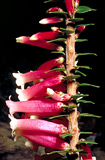
|
|
Select the thumbnail image or plant name for a higher resolution image (19k).
|
Mathias Hartmann
Germany
Matzbaer@t-online.de
Good to hear from You...we don't get much correspondence from Germany.
You can find some information on Epacris longiflora on our web site.
The site also has general propagation notes.
E.longiflora is not the easiest plant to strike from cuttings - the use of root hormones (IBA/NAA) seems to help. The roots are very fine and easily damaged.
In nature E.longiflora grows in sheltered, moist areas (but not waterlogged). Drainage must be very good. It prefers soils that are slightly acid.
Hope this helps.

What Banksia is That??
I bought a Banksia some years ago and I was told that it was called the "possum banksia" which I believe is B.baueri. This banksia is well over two metres tall and the old cones are about 20cm long. Is there a possum banksia (B.baueri) and could you describe it for me?
Last week I visited the Tasmanian Botanic Gardens in Hobart and I saw a B.serrata which looked very similar to the shrub in my garden. Is B.serrata anything like B.baueri? I would appreciate it if you could enlighten me in some way.
Thanks
Geraldine Goodwin
Australia
Yes....Banksia baueri is called "possum banksia". It's a Western Australian species which is not commonly cultivated in the east. It is vaguely like B.serrata but nowhere near as large. B.baueri rarely exceeds 2-3 metres while B.serrata can get to 5 or 6 metres. The flower spikes of B.baueri are much larger than B.serrata and can be 30 cm long by 15 cm diameter and are of a woolly cream/grey colour. B.serrata has flower clusters about half that size, usually cream and not woolly.
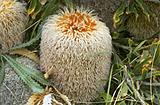
|
It sounds as if your plant could be Banksia baueri but it's impossible to tell without seeing it. Maybe the photo will help.
Select the thumbnail image or highlighted name for a higher resolution image (47k).
|

A Plague of Scale
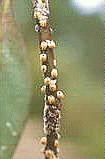 
I was wondering if you could please help me.I own a property at Hill Top in the Southern Highlands of New South Wales and, in the last couple of years, I've had a major problem with scale insects of almost plague proportions, concentrating mainly on the many acacias growing there. I've tried using Malathon and White Oil but it hasn't really helped.
Is there any alternative products or methods I can try? I had heard that Ladybirds are a natural predator of scale. Is this true and, if so, is it a viable control for scale. If ladybirds can be used where can you get them from?
Any help in this matter would be greatly appreciated.
Rob Jones
Hill Top
New South Wales
robpj@acay.com.au
John Wrigley replies........
"Firstly, I don't think ladybirds have much effect on scale. Their larvae are very good predators of aphids and should be encouraged for that purpose. Also I don't know of any supplier of ladybirds.
I would use a mixture of white oil and Rogor 40 rather than malathion. Rogor is systemic and tends to control the scale from the inside as well as any contact. The white oil is used to suffocate the scale insect, so a thorough coverage of the scale is essential. This treatment should kill the insect in one application but if it persists, then try a second application. Use both chemicals at the recommmended strength.
Good luck."

[Front Page] [Features] [Departments] [Society Home] [Subscribe]
Australian Plants online - December 1999
Association of Societies for Growing Australian Plants
|